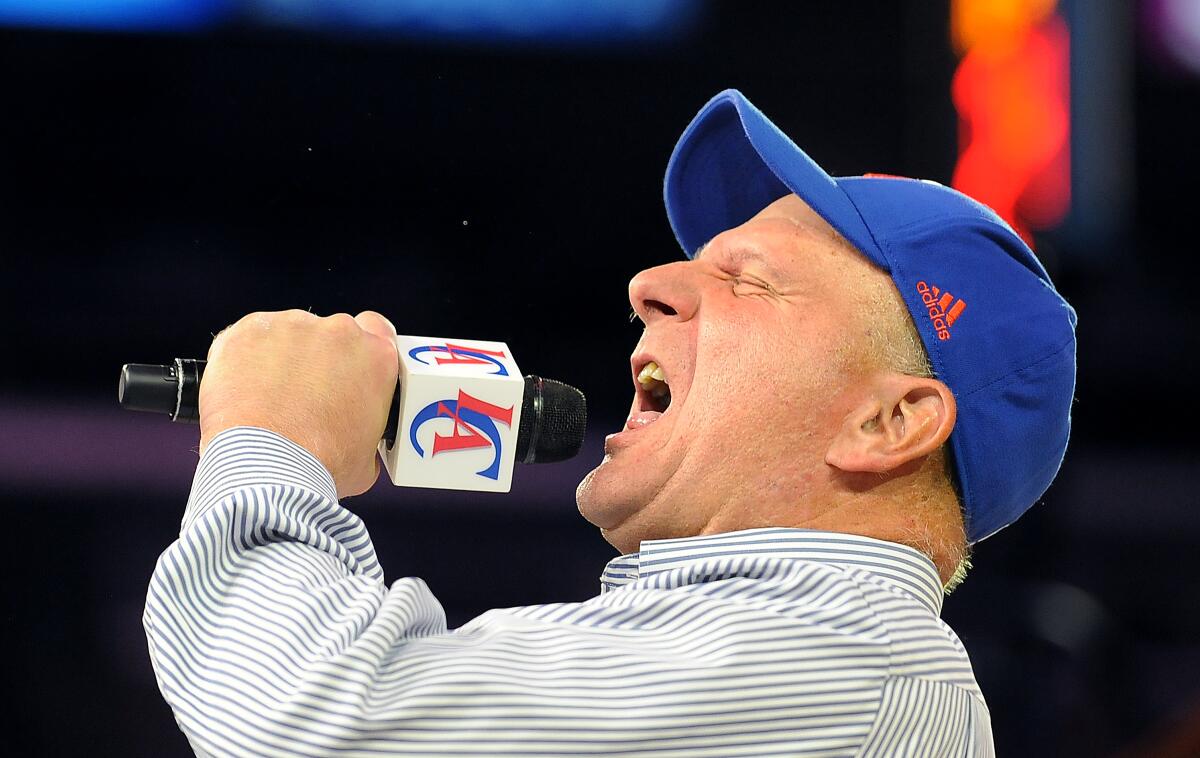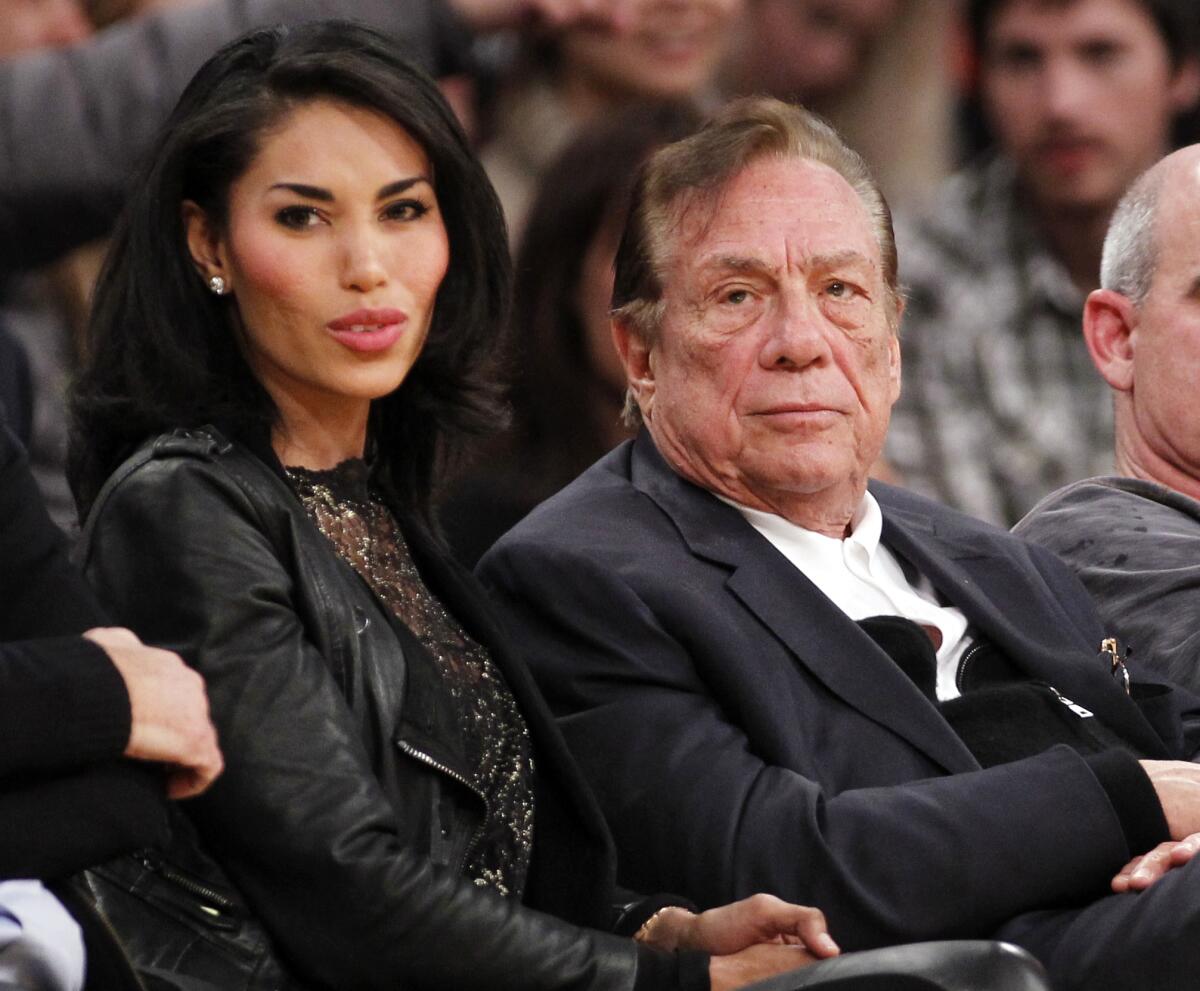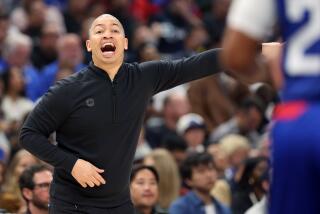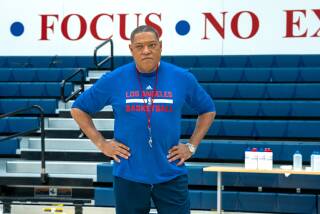Exorcising of ‘Clippers Curse’ began years before arrival of Leonard and George

- Share via
The email arrived on March 9, 2010, around halftime of a Clippers game in Orlando.
A month after Mike Dunleavy stepped down as the Clippers coach, a team news release announced he was out as general manager too. That was news to Dunleavy. He learned of his firing through concerned text messages from friends, he said at the time. When he called then-team owner Donald Sterling for an explanation, he had to settle for leaving a message.
The firing’s timing left staffers shaking their heads, capping a decade that included one winning season and began with a Sports Illustrated cover proclaiming the Clippers “the worst franchise in sports history.”
Yet already, there were signs the team’s next decade would be different.
“Someone in my past recently just made a very bold statement,” coach Phil Jackson said of the Clippers, on the eve of the 2010 postseason that saw his Lakers claim a second consecutive NBA title. “He feels very strongly that this is a franchise that’s going to move forward in the next year.”
The man from the coach’s past was prescient about the Clippers’ future.
Adam Silver told NBA players that a return to the court is up in the air but that games could be held in Las Vegas or Orlando, likely without fans.
From their arrival in Los Angeles in 1984 through 2010, the Clippers owned the league’s second-worst winning percentage (.348) and zero buzz, producing two all-NBA selections and seven All-Star game appearances. During the last 10 seasons, including the current coronavirus-paused campaign, the Clippers have won 60.9% of their games — fifth-best in the NBA, including a 27-11 record against the Lakers — with 12 all-NBA selections and 12 All-Star appearances.
In the process, they gained relevancy, shed a disgraced owner and earned audiences with top free agents, including LeBron James and Kevin Durant, and signed another in Kawhi Leonard.
The decade wasn’t without invocations of the so-called “Clippers Curse.” A 2011 trade with Cleveland sent the Cavaliers an unprotected first-round pick that, despite minuscule odds, became the No. 1 overall selection used to select Kyrie Irving. From 2013-17, the Clippers held a postseason series lead, only to be eliminated. They are still chasing their first conference final appearance.
Yet, by the time the NBA suspended its season in March, the Clippers had already clinched a ninth consecutive winning season, the longest such streak in the franchise’s 50-year history.

“When anybody talks about Clippers history, there is no history until you start winning,” said Vinny Del Negro, the coach for three seasons beginning in 2011.
The turnaround is known for its most high-profile plot points: Drafting future All-Star Blake Griffin No. 1 overall in 2009; trading for point guard Chris Paul in 2011, after Paul’s trade to the Lakers was vetoed by then-NBA Commissioner David Stern; trading for coach Doc Rivers in 2013; and Steve Ballmer’s purchase of the team in 2014, after Sterling was banned for life by the league after being recorded making racist statements.
By revamping the front office in 2017, the Clippers began assembling the pieces that led to last summer’s franchise-changing addition of Leonard, as a free agent, and Paul George, through a trade. They formed the backbone of a roster that owns the NBA’s fourth-best record this season.
But while tracing back the roots of that turnaround, many NBA figures pointed to other key moments too — such as the momentum that built because of a building.
Because Sterling made his fortune in real estate by buying existing buildings, not developing new ones, rumors of a dedicated practice facility had remained only talk for years, leaving the team to practice at Los Angeles Southwest College, where players were known to nervously leave their luxury cars unattended in the parking lot. In 2004, they moved to a health club in El Segundo, where weekend warriors lifted weights only feet from an NBA practice.

Upon the opening of the team’s Playa Vista practice facility in 2009, its amenities were state-of-the-art, its location minutes from the beach and its mere presence touted as a symbol of renewed commitment. When Griffin arrived for his predraft workout in 2009, team employees sensed relief from his family amid the tour.
“I couldn’t believe it,” said Ralph Lawler, the team’s broadcaster for 40 years before his retirement last season. “That was probably the first step toward being the big time.”
Soon, the facility was hosting offseason pick-up games so loaded with All-Stars that Jay-Z was known to drop by to watch. The Clippers made sure to highlight their new building during their free-agency pitch to James in 2010. They also made the case that of James’ six suitors, their roster was best suited for him to plug and play.
With Griffin’s potential yet to be glimpsed because of a knee injury that scuttled his rookie season, the Clippers couldn’t prove what they were selling. But the face time with one of the league’s most powerful stars was considered more than a missed opportunity.
A year later, when New Orleans granted teams permission to speak with Paul, the Clippers had proof to go with their pitch. Griffin was a breakout star whose highlights created cultural cachet beyond hardcore basketball fans. Paul could also throw lobs to 7-foot leaper DeAndre Jordan.

They also showed Paul that the team’s turnaround had already received buy-in from a pair of respected veterans.
Five days before Paul arrived, the team beat out New Jersey, San Antonio and Chicago to sign Caron Butler to a three-year, $24-million deal. Then, two days before the Paul trade, the Clippers won a waiver claim for 2004 NBA Finals MVP Chauncey Billups despite a stern warning from Billups’ agent to every team that the point guard intended only to sign with Miami.
The Clippers bid anyway. Lawler was in the office of then-team President Andy Roeser when the call came that Billups had been claimed. It was up to then-general manager Neil Olshey and Del Negro to persuade him that the franchise with two winning seasons in its previous 27 was changing, even if Sterling remained owner.
“It’s not the old Clippers,” Del Negro said. “This is a new situation, and I wanted them to be part of it.”
Jordan could win the adoration of white America, but only as long as he didn’t talk about what it meant to be black in America.
It was important during the early years of the turnaround to get a stamp of approval from “very respectable players,” said one former staffer who did not want to speak publicly because he still works in the league, because “the Clippers didn’t have a reputation of doing that.”
Grant Hill, Lamar Odom and Jamal Crawford signed up before the 2012-13 season, Del Negro’s last. Veterans such as JJ Redick, Patrick Beverley and Lou Williams have been key additions during Rivers’ tenure.
“My mind-set there was to first build a constructive culture of winning which hadn’t happened in a long time,” Del Negro said. “The only way you do that is by putting quality players together and quality people and building every day.
“Our playoff success wasn’t where we wanted to be but considering where we came from two years back it was pretty remarkable where the organization was and where it was at.”

Lawler sensed things had changed after a morning shootaround in Utah on Feb. 1, 2012, only weeks after Butler, Billups and Paul were added. He asked the new backcourt whether they knew the Clippers had lost 16 consecutive games in Salt Lake City. Revealing such trivia to players during the lean Clippers years might have led a player to wilt, Lawler said. But Billups and Paul instead responded as though it was an affront.
That night, the Clippers ended the streak, with Paul scoring 34 points.
Message received.
“That showed so much about how different that team was,” Lawler said, “from any Clipper team before.”
More to Read
Go beyond the scoreboard
Get the latest on L.A.'s teams in the daily Sports Report newsletter.
You may occasionally receive promotional content from the Los Angeles Times.








